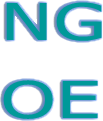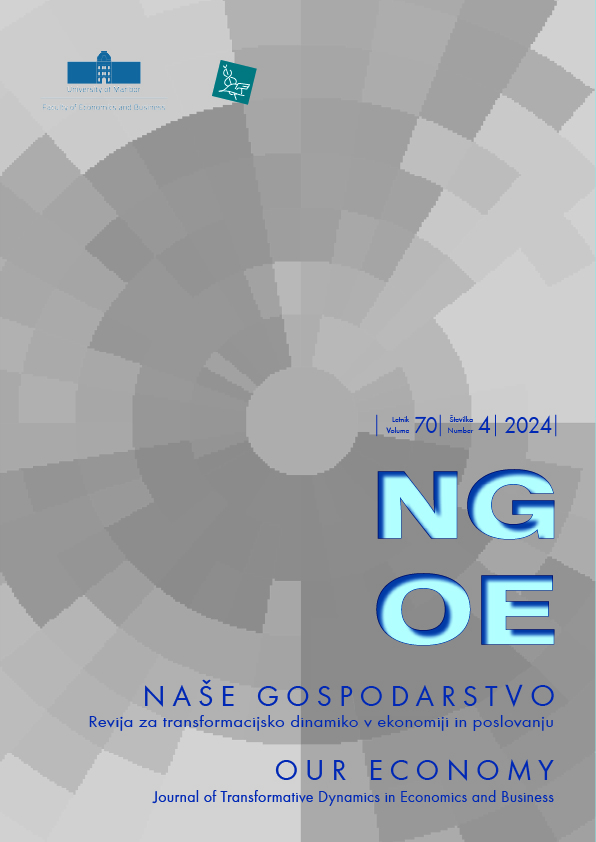Work-Related Factors Influencing Presenteeism in Croatia during COVID-19: A Logistic Regression Approach
Abstract
This article analyses the work-related factors that impact the occurrence of presenteeism in Croatia during the COVID-19 pandemic. The main objective is to examine the connection between key variables and the prevalence of presenteeism among employees in Croatia. The study used logistic regression analysis to examine data from the 2021 European Working Condition Telephone Survey (EWCTS), encompassing a sample of 491 employees from Croatia. The study investigated work-related factors such as job demands, working hours, supervisory responsibilities, telework, and cooperation with coworkers. The analysis also takes into account demographic control variables, including age, gender, and educational level. The findings suggest that there is a significant relationship between work stressors and presenteeism. Employees who lack good collaboration with colleagues are more prone to attending work even when they are unwell. Age was also determined to be a significant factor. The study indicates that work-related factors have an impact on presenteeism in Croatia. To mitigate the adverse effects of presenteeism, firms should adopt strategies to enhance working conditions and foster a conducive work atmosphere. The results offer valuable perspectives for future research and practical strategies to reduce presenteeism and improve employee wellbeing.
Downloads
References
Arnold, D., & de Pinto, M. (2015). How are Work-related Characteristics Linked to Sickness Absence and Presenteeism? Theory and Data. Schmollers Jahrbuch, 135(4), 465–498. DOI: https://doi.org/10.3790/schm.135.4.465
Aronsson, G., & Gustafsson, K. (2005). Sickness Presenteeism: Prevalence, Attendance-Pressure Factors, and an Outline of a Model for Research. Journal of Occupational and Environmental Medicine, 47(9), 958–966. DOI: https://doi.org/10.1097/01.jom.0000177219.75677.17
Aronsson, G., Gustafsson, K., & Dallner, M. (2000). Sick but yet at work. An empirical study of sickness presenteeism. Journal of Epidemiology & Community Health, 54(7), 502–509. DOI: https://doi.org/10.1136/jech.54.7.502
Bergström, G., Bodin, L., Hagberg, J., Aronsson, G., & Josephson, M. (2009). Sickness Presenteeism Today, Sickness Absenteeism Tomorrow? A Prospective Study on Sickness Presenteeism and Future Sickness Absenteeism. Journal of Occupational & Environmental Medicine, 51(6), 629–638. DOI: https://doi.org/10.1097/JOM.0b013e3181a8281b
Bockerman, P., & Laukkanen, E. (2010). What makes you work while you are sick? Evidence from a survey of workers. The European Journal of Public Health, 20(1), 43–46. DOI: https://doi.org/10.1093/eurpub/ckp076
Brborović, H., & Brborović, O. (2017). Patient safety culture shapes presenteeism and absenteeism: a cross-sectional study among Croatian healthcare workers. Archives of Industrial Hygiene and Toxicology, 68(3), 185–189. DOI: https://doi.org/10.1515/aiht-2017-68-2957
Brborović, H., Brborović, O., Brumen, V., Pavleković, G., & Mustajbegović, J. (2014). Are nurse presenteeism and patient safety culture associated: a cross-sectional study. Archives of Industrial Hygiene and Toxicology, 65(2), 149–156. DOI: https://doi.org/10.2478/10004-1254-65-2014-2462
Brborović, H., Brborović, O., & Mustajbegović, J. (2016). Looking for the Possible Association Between Stress, Presenteeism and Absenteeism Among Croatian Nurses: A Cross-Sectional Study. Iranian Journal of Psychiatry and Behavioral Sciences, In Press(In Press). DOI: https://doi.org/10.17795/ijpbs-4587
Breaugh, J. A. (1985). The Measurement of Work Autonomy. Human Relations, 38(6), 551–570. DOI: https://doi.org/10.1177/001872678503800604
Caverley, N., Barton Cunningham, J., & MacGregor, J. N. (2007). Sickness presenteeism, sickness absenteeism, and health following restructuring in a public service organization. In Journal of Management Studies (Vol. 44, Issue 2, pp. 304–319). DOI: https://doi.org/10.1111/j.1467-6486.2007.00690.x
Cho, Y.-S., Park, J. B., Lee, K.-J., Min, K.-B., & Baek, C.-I. (2016). The association between Korean workers’ presenteeism and psychosocial factors within workplaces. Annals of Occupational and Environmental Medicine, 28(1), 41. DOI: https://doi.org/10.1186/s40557-016-0124-1
Demerouti, E., Le Blanc, P. M., Bakker, A. B., Schaufeli, W. B., & Hox, J. (2009). Present but sick: a three‐wave study on job demands, presenteeism and burnout. Career Development International, 14(1), 50–68. DOI: https://doi.org/10.1108/13620430910933574
Eurofund. (2024). European Working Conditions Telephone Survey, 2021. In UK Data Service. SN: 8098: Vol. 3rd Edition. UK Data Service. SN: 9026.
Gerich, J. (2022). Home-Based Telework and Presenteeism. Journal of Occupational & Environmental Medicine, 64(3), 243–249. DOI: https://doi.org/10.1097/JOM.0000000000002414
Gosselin, E., Lemyre, L., & Corneil, W. (2013). Presenteeism and absenteeism: Differentiated understanding of related phenomena. Journal of Occupational Health Psychology, 18(1), 75–86. DOI: https://doi.org/10.1037/a0030932
Goto, E., Ishikawa, H., Okuhara, T., Ueno, H., Okada, H., Fujino, Y., & Kiuchi, T. (2020). Presenteeism among workers: health-related factors, work-related factors and health literacy. Occupational Medicine, 70(8), 564–569. DOI: https://doi.org/10.1093/occmed/kqaa168
Gustafsson, K., & Marklund, S. (2011). Consequences of sickness presence and sickness absence on health and work ability: A Swedish prospective cohort study. International Journal of Occupational Medicine and Environmental Health, 24(2). DOI: https://doi.org/10.2478/s13382-011-0013-3
Gustafsson Sendén, M., Schenck-Gustafsson, K., & Fridner, A. (2016). Gender differences in Reasons for Sickness Presenteeism - a study among GPs in a Swedish health care organization. Annals of Occupational and Environmental Medicine, 28(1), 50. DOI: https://doi.org/10.1186/s40557-016-0136-x
Hale, T., Angrist, N., Goldszmidt, R., Kira, B., Petherick, A., Phillips, T., Webster, S., Cameron-Blake, E., Hallas, L., Majumdar, S., & Tatlow, H. (2021). A global panel database of pandemic policies (Oxford COVID-19 Government Response Tracker). Nature Human Behaviour, 5(4), 529–538. DOI: https://doi.org/10.1038/s41562-021-01079-8
Hansen, C. D., & Andersen, J. H. (2008). Going ill to work – What personal circumstances, attitudes and work-related factors are associated with sickness presenteeism? Social Science & Medicine, 67(6), 956–964. DOI: https://doi.org/10.1016/j.socscimed.2008.05.022
Hobfoll, S. E. (2001). The Influence of Culture, Community, and the Nested‐Self in the Stress Process: Advancing Conservation of Resources Theory. Applied Psychology, 50(3), 337–421. DOI: https://doi.org/10.1111/1464-0597.00062
Ishimaru, T., & Fujino, Y. (2021). Association between work style and presenteeism in the Japanese service sector. Journal of Occupational Health, 63(1). DOI: https://doi.org/10.1002/1348-9585.12211
Janssens, H., Clays, E., de Clercq, B., de Bacquer, D., Casini, A., Kittel, F., & Braeckman, L. (2015). Association between psychosocial characteristics of work and presenteeism: A cross-sectional study. International Journal of Occupational Medicine and Environmental Health, 29(2), 331–344. DOI: https://doi.org/10.13075/ijomeh.1896.00588
Johns, G. (2010). Presenteeism in the workplace: A review and research agenda. Journal of Organizational Behavior, 31(4), 519–542. DOI: https://doi.org/10.1002/job.630
Karanika-Murray, M., & Biron, C. (2020). The health-performance framework of presenteeism: Towards understanding an adaptive behaviour. Human Relations, 73(2), 242–261. DOI: https://doi.org/10.1177/0018726719827081
Kinman, G., & Grant, C. (2021). Presenteeism during the COVID-19 pandemic: risks and solutions. Occupational Medicine, 71(6–7), 243–244. DOI: https://doi.org/10.1093/occmed/kqaa193
Lalić, H., & Hromin, M. (2012). Presenteeism towards absenteeism: manual work versus sedentary work, private versus governmental--a Croatian review. Collegium Antropologicum, 36(1), 111–116.
Leineweber, C., Westerlund, H., Hagberg, J., Svedberg, P., Luokkala, M., & Alexanderson, K. (2011). Sickness Presenteeism Among Swedish Police Officers. Journal of Occupational Rehabilitation, 21(1), 17–22. DOI: https://doi.org/10.1007/s10926-010-9249-1
Lohaus, D., & Habermann, W. (2018). Präsentismus. In Präsentismus. Springer Berlin Heidelberg. DOI: https://doi.org/10.1007/978-3-662-55701-3
Lu, L., & Cooper, C. L. (2022). Sickness Presenteeism as a Link between Long Working Hours and Employees’ Outcomes: Intrinsic and Extrinsic Motivators as Resources. International Journal of Environmental Research and Public Health, 19(4), 2179. DOI: https://doi.org/10.3390/ijerph19042179
Margetić, B., Peraica, T., Stojanović, K., & Ivanec, D. (2021). Predictors of emotional distress during the COVID-19 pandemic; a Croatian study. Personality and Individual Differences, 175, 110691. DOI: https://doi.org/10.1016/j.paid.2021.110691
Miraglia, M., & Johns, G. (2016). Going to work ill: A meta-analysis of the correlates of presenteeism and a dual-path model. Journal of Occupational Health Psychology, 21(3), 261–283. DOI: https://doi.org/10.1037/ocp0000015
Nordenmark, M., Hagqvist, E., & Vinberg, S. (2019). Sickness Presenteeism among the Self-employed and Employed in Northwestern Europe—The Importance of Time Demands. Safety and Health at Work, 10(2), 224–228. DOI: https://doi.org/10.1016/j.shaw.2019.01.003
Patel, C., Biron, M., Cooper, S. C., & Budhwar, P. S. (2023). Sick and working: Current challenges and emerging directions for future presenteeism research. Journal of Organizational Behavior, 44(6), 839–852. DOI: https://doi.org/10.1002/job.2727
Preisendörfer, P. (2010). Präsentismus. Prävalenz und Bestimmungsfaktoren unterlassener Krankmeldungen bei der Arbeit. German Journal of Research in Human Resource Management, 24(4), 401–408.
Robertson, I., Leach, D., Doerner, N., & Smeed, M. (2012). Poor Health but Not Absent. Journal of Occupational & Environmental Medicine, 54(11), 1344–1349. DOI: https://doi.org/10.1097/JOM.0b013e31825dff4b
Ruhle, S. A., Breitsohl, H., Aboagye, E., Baba, V., Biron, C., Correia Leal, C., Dietz, C., Ferreira, A. I., Gerich, J., Johns, G., Karanika-Murray, M., Lohaus, D., Løkke, A., Lopes, S. L., Martinez, L. F., Miraglia, M., Muschalla, B., Poethke, U., Sarwat, N., … Yang, T. (2020). “To work, or not to work, that is the question” – Recent trends and avenues for research on presenteeism. European Journal of Work and Organizational Psychology, 29(3), 344–363. DOI: https://doi.org/10.1080/1359432X.2019.1704734
Skagen, K., & Collins, A. M. (2016). The consequences of sickness presenteeism on health and wellbeing over time: A systematic review. Social Science & Medicine, 161, 169–177. DOI: https://doi.org/10.1016/j.socscimed.2016.06.005
Steidelmüller, C., Meyer, S.-C., & Müller, G. (2020). Home-Based Telework and Presenteeism Across Europe. Journal of Occupational & Environmental Medicine, 62(12), 998–1005. DOI: https://doi.org/10.1097/JOM.0000000000001992
Copyright (c) 2024 Sabina Veršič

This work is licensed under a Creative Commons Attribution-NonCommercial-NoDerivatives 4.0 International License.

